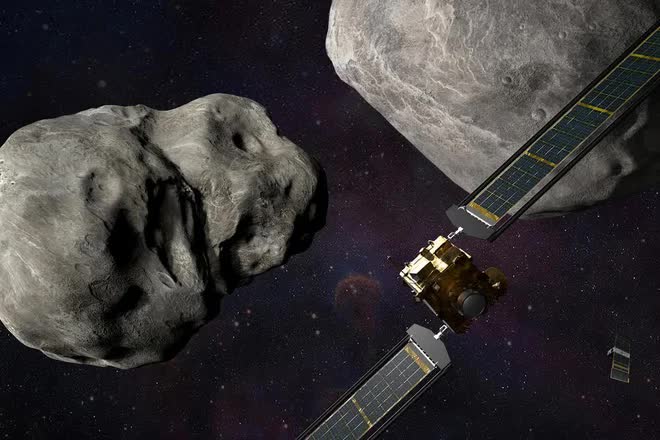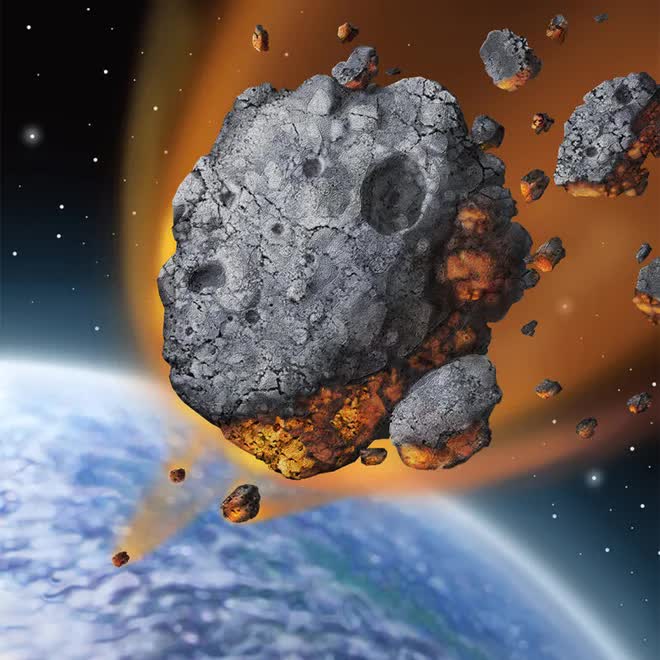Unexpected success: NASA spacecraft ‘blows away’ the old orbit of the asteroid!
- Tram Ho
For the first time in history, humans were able to change the orbit of a celestial body.

According to the latest space news from NASA, the Double Asteroid Redirection Test (DART) spacecraft after hitting the asteroid Dimorphos succeeded in CHANGING its orbit.
Asteroid Dimorphos – about 11,000,000 km from our Earth – is harmless to our planet, and NASA wants to launch a spacecraft to conduct testing to see if in the future, humans can prevent an asteroid. asteroid/meteorite collision with Earth by deflecting its orbit or not.
The Dart spacecraft plowed a large impact crater into the asteroid Dimorphos on September 26, 2022, sending debris hurled into space and creating a trail of dust and debris resembling a towing comet several thousand kilometers long.
Thanks to its temporary new tail, Dimorphos has transformed into a man-made comet.

The Hubble Space Telescope captured this image of the asteroid Dimorphos after the collision with the Dart spacecraft. Photo: NASA / ESA / STScI / Hubble
The reason for the collision was made 2 weeks ago, but on October 11, 2022, NASA officially announced the successful results of Dart or not. That’s because it took scientists on the ground many nights in a row with telescopes from Chile and South Africa to determine how much the impact would change the path of the 160-meter-long Dimorphos asteroid. around another meteorite called Didymos, which is much larger.
SUCCESS UNDERSTANDING
Before impact, Dimorphos took 11 hours and 55 minutes to orbit the asteroid Didymos. Scientists had predicted the collision would cut that time by about 10 minutes, but NASA Bill Nelson said the collision shortened Dimorphos’ orbit by 32 minutes (from 11:55 am. minutes to 11:23 minutes).
“This is a success beyond the expectations of many people. For the first time in human history, humans have been able to change the orbit of a celestial body.” – Lori Glaze, NASA’s director of planetary science glad to say.

The Dimorphos and Didymos binary asteroid system. Photo: Steve Gribben / Johns Hopkins APL / NASA / AP
The team’s scientists said the amount of debris appeared to play a role in the results. The impact could also cause the Dimorphos to wobble a bit, said NASA program scientist Tom Statler. The two asteroids were initially separated by 1.2 km, after the collision, that distance was only measured in tens, hundreds of meters.
Launched in 2021, the Dart (Double Asteroid Redirection Test) spacecraft is the size of a vending machine, built by the Johns Hopkins University Applied Physics Laboratory (USA). The total cost for this project is 325 million USD, of which the construction cost of DART train is more than 300 million USD.
Dart’s mission is almost a suicide mission, because after more than a year of traveling in space, Dart arrived at an asteroid 11 million km from Earth and then plunged into it at a speed of 22,500 km / h.

NASA’s Double Asteroid Redirection Test (DART) spacecraft sits amid a Falcon 9 rocket at Vandenberg Space Force Base in California on November 16, 2021. Source: Ed Whitma/Johns Hopkins APL/NASA
Daniel Brown, an astronomer at Nottingham Trent University in the UK, said: “This is a tremendous feat, not least in taking the first step in being able to protect us from the effects of the Earth’s moons. future asteroids, but also shows that human space technology is getting more and more amazing.”
More research is needed to not only identify the countless more asteroids/meteorites out there, but also to determine their composition – some are solid, while others are, the team’s scientists say is a pile of rubble.
Tom Statler said: “We shouldn’t be too eager to say that a test on one asteroid would tell us exactly how every other asteroid would have had the same result in a similar situation. However, the success in attempting to deflect the orbit of asteroid Dimorpho opens up a new path for us to protect ourselves in space.”
DESTROY FROM SPACE
According to NASA, no known asteroid larger than 140 meters – large enough to devastate a city – has a significant chance of hitting Earth in the next 100 years. But anything is possible, regardless of human prediction. Therefore, we need to actively prevent it.
For example, geological records show that a 9.6 km wide asteroid hit the Earth 66 million years ago, pushing the world into a long winter that led to the mass extinction of dinosaurs along with 75 % of all species.

Anything is possible, regardless of human prediction. Therefore, we need to actively prevent it. Photo: Internet
NASA plans to launch in 2026 a telescope called the Near-Earth Object Survey (NEO) to better characterize potentially dangerous 140-meter asteroids and comets coming within 48,280. 320 km.
After the initial successful assessment of the Dart spacecraft, astronomers did not stop there.
For a more detailed look at this man-made collision, the European Space Agency’s Hera mission will conduct a follow-up investigation of Dimorphos and the larger asteroid in the system, Didymos .
Specifically, the Hera mission will launch in 2024. This spacecraft, along with two CubeSats satellites, will arrive at the asteroid system (including Dimorphos and Didymos) 2 years later.
Hera will also study asteroids, measure Dimorphos’ physical properties and examine the DART crater and Dimorphos’ orbit around Didymos, with the aim of establishing an effective future Earth defense strategy. than.
Source: AP, Sciencealert
Source : Genk
